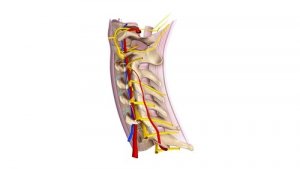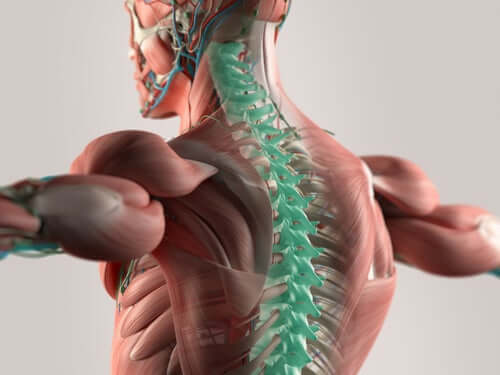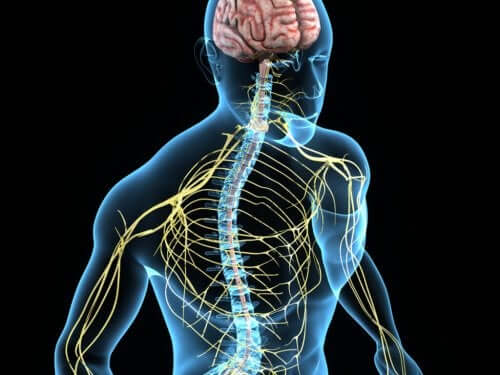Learn All about Cervical Spinal Nerves

Cervical spinal nerves are a group of eight spinal nerves from the eight cervical vertebrae that originate in the spinal cord. These eight vertebrae, C-1 through C-8, start from the base of the skull.
All cervical spinal nerves, except C-1 (which normally has no dorsal root), are linked to a dermatome. A dermatome is an area of skin supplied by a spinal nerve.
Spinal nerves
So, cervical spinal nerves encompass eight spinal nerves, and these, in turn, are a set of nerves (approximately 31 to 33 nerves) that belong to the somatic nervous system, whose function is to innervate different parts of the body.
They’re composed of a sensory root and a motor root. The sensory roots give sensitivity to the muscles they innervate. In addition to this, the motor roots allow the muscles to contract automatically. Thanks to this composition, they achieve their goal.
The spinal nerves, which include the cervical spinal nerves, are the following:
- Eight pairs of cervical nerves (C1-C8)
- 12 thoracic nerves (T1-T12)
- Coccygeal nerve
- Five sacral nerves (S1-S5)
- Five lumbar nerves (L1-L5)
You may also want to read: Smoothies and Teas for the Nervous System
Characteristics of cervical spinal nerves

First of all, as we already mentioned, they’re mixed nerves. In other words, they’re composed of both sensory and motor fibers.
Second of all, all the divisions of the ventral rami, except the thoracic nerves (T1 to T12), form several branches known as nerve plexuses. These plexuses appear in the cervical, brachial, and lumbo sacral areas.
Within these interconnected branches, the fibers that originate in the ventral branches intersect and redistribute so that each resulting ramus contains fibers of different spinal nerves.
In addition, those from each ventral ramus travel to the periphery of the body by way of different routes on the branches.
For this reason, each limb muscle with be stimulated by more than one spinal nerve. Consequently, if there’s damage to one of the segments of the spinal cord or in one of the rami, the tip doesn’t have to remain completely unused.
Cervical spinal nerves
The ventral rami of the first four spinal nerves form the cervical plexus. Its branches are skin nerves that stimulate the skin of the following areas, thus transmitting sensory impulses:
- Neck
- Ear
- The back of the head
- Shoulder
In addition, other branches supply the anterior muscles of the neck. Also, the phrenic nerve fibers, that group fibers mainly from C-3 and C-4, originate from the cervical plexus. The phrenic nerve passes between the chest to the diaphragm, the most important respiration muscle.
You should also read: Effective Infusions for Improving the Nervous System
The ventral nerves of the cervical spinal nerves C-5 and C-8, along with the anterior ramus of T-1, form the brachial plexus. Its roots are responsible for providing energy to the shoulders and upper extremities.
Finally, the dorsal cutaneous branches are responsible for the stimulation of the cervical facet. Also, from these roots, muscle branches from the head and neck originate, as well as the skin comprised between the vertex (uppermost surface of the head) and shoulders.
Division of the cervical spinal nerves

Like all other spinal nerves, they’re divided into dorsal and ventral rami after they leave the spinal canal. As they leave the spinal cord, the ventral and dorsal roots join to form the spinal or dorsal root ganglion.
Then, these ganglia divide into:
- Ventral or anterior ramus. This is a thick branch that intertwines, divides, and anastomoses with the anterior rami of the other spinal nerves to form, as we’ve mentioned, the cervical plexus.
- Dorsal or posterior ramus. This is the lower division of the spinal cord, and it’s much thinner than the previous one.
In conclusion, cervical nerves are an important part of the nervous system. We hope you’ve enjoyed learning about them and seen the importance of looking after them in order to avoid different illnesses and conditions.
All cited sources were thoroughly reviewed by our team to ensure their quality, reliability, currency, and validity. The bibliography of this article was considered reliable and of academic or scientific accuracy.
- Gilroy, A. M., MacPherson, B. R., Ross, L. M., Schünke, M., Schulte, E., & Schumacher, U. (2008). Nervios Craneales. In Prometheus: Atlas de Anatomía.
- SABORÍO BRENES, P. (2014). El plexo braquial. Revista OMNIA. https://doi.org/10.1016/S1286-935X(03)72271-0
- Espino de la Cueva, C., & Núlez Herrera, D. (2012). Medula espinal.
- Lesión de la médula espinal: Esperanza en la investigación. El Instituto Nacional de Trastornos Neurológicos y Accidentes Cerebrovasculares. https://espanol.ninds.nih.gov/trastornos/lesion_de_la_medula_espinal.htm
- Antonio José Carrascosa Fernández (2020). Nervios cervicales o nervios raquídeos cervicales. Dolopedia. https://dolopedia.com/articulo/nervios-cervicales-o-nervios-raquideos-cervicales#article-credits.
This text is provided for informational purposes only and does not replace consultation with a professional. If in doubt, consult your specialist.








